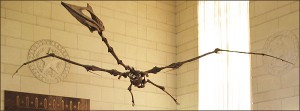The Texas Pterosaur
Soaring through the Great Hall of the Texas Natural Science Center’s exhibit hall, the Texas Memorial Museum, is the largest flying creature ever discovered. It was found in 1971 by Douglas Lawson, a graduate student working with the Texas Memorial Museum’s Dr. Wann Langston, Jr. It lived in what is now Big Bend National Park, in West Texas, about 65 million years ago, during the late Cretaceous Period. Its wingspan is about 40 feet.
Pterosaurs (pronounced “TARE-uh-soars”) were flying reptiles, and they were not close relatives of either birds or bats. When Lawson first found bone fragments from this animal, he was not sure what they were. He and Langston examined the fragments and realized that the bone’s shape and hollow structure could only be those of a pterosaur. The Texas Pterosaur is one of the most famous finds in the history of paleontology. Its discovery was reported in journals, newspapers, and radio and television broadcasts all over the world. Later, it became famous again, when CalTech’s Paul MacCready built a flying model of the creature in the mid-1980’s.


